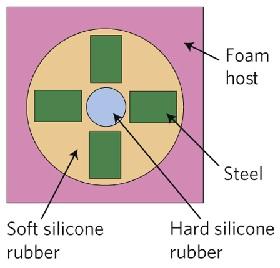Using AI to control energy for indoor agriculture
30 September 2024
Published online 13 July 2011

Engineering artificial materials to possess properties unlike anything found in nature is the goal of researchers working in metamaterials. Now, an international group have used a computer model to demonstrate that a foam sheet can, in theory, behave like both a liquid and a solid, and published their findings in Nature Materials.
One defining difference between liquids and solids is that solids can support shear forces. Push and pull on two adjacent regions of a solid, and it will deform slightly, but resist further movement; in a liquid, the two parts will instead flow. Consequently, a solid can carry elastic waves that involve shearing motions, while a liquid cannot.
To investigate how an apparently solid metamaterial might respond to a force as a liquid would, , a team of engineers, including Ying Wu at the King Abdullah University of Science and Technology (KAUST) in Thuwal, Saudi Arabia, used computer simulations to illustrate a sheet of foam containing an array of small rubber and steel rods. The researchers configured the material's structures to manipulate the foam's natural vibrations, hoping to blur the line between our concepts of solids and liquids.
Stimulating this metamaterial to vibrate at a certain frequency range prompted the foam to act like a fluid: shear waves could not propagate through it. Meanwhile, at a different frequency range, the material was able to carry the shear waves, acting as a solid, but only in certain directions. In certain other directions, it again acted like a fluid.
"Materials like this," says Wu, "will significantly extend our ability to filter and channel vibrational energy as it moves through solid structures."
In fact, engineers might find such materials useful, for example, in insulating buildings from the devastating vibrations of earthquakes, or in designing helmets that can withstand bigger impacts without transmitting the shock to the head.
doi:10.1038/nmiddleeast.2011.89
Stay connected: